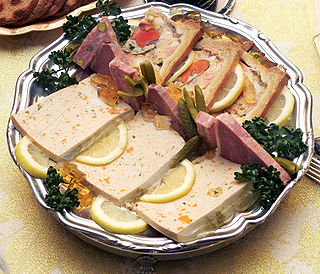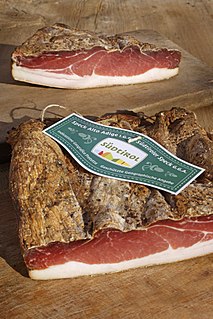 W
WCharcuterie is a French term for a branch of cooking devoted to prepared meat products, such as bacon, ham, sausage, terrines, galantines, ballotines, pâtés, and confit, primarily from pork.
 W
WConfit is any type of food that is cooked slowly over a long period of time as a method of preservation.
 W
WD’Artagnan (D'Artagnan, Inc., also known as D'Artagnan Foods) is a food seller and manufacturer of beef, pork, lamb, veal, pâtés, sausages, smoked and cured charcuterie, all-natural and organic poultry, game, free-range meat, foie gras, wild mushrooms and truffles.
 W
WFatback is a cut of meat from a domestic pig. It consists of the layer of adipose tissue under the skin of the back, with or without the skin. Fatback is "hard fat" and is distinct from the visceral fat that occurs in the abdominal cavity which is called "soft fat" and is used to produce leaf lard.
 W
WIn French cuisine, galantine is a dish of boned stuffed meat, most commonly poultry or fish, that is usually poached and served cold, often coated with aspic. Galantines are often stuffed with forcemeat, and pressed into a cylindrical shape. Since boning poultry can be difficult and time-consuming for the novice, this is a rather elaborate dish, which is often lavishly decorated, hence its name, connoting a presentation at table that is galant, or urbane and sophisticated. In the later nineteenth century the technique's origin was already attributed to the chef of the marquis de Brancas.
 W
WHam is pork from a leg cut that has been preserved by wet or dry curing, with or without smoking. As a processed meat, the term "ham" includes both whole cuts of meat and ones that have been mechanically formed.
 W
WA hot link is a type of sausage used in the cuisine of the Southern United States, and a part of American barbecue, soul food, and Cajun and Louisiana Creole cuisines. It is also a part of Texan cuisine and the cuisine of Chicago, Illinois. The hot link is usually prepared using pork, beef, or a combination of both. It is sometimes used as an ingredient in other dishes, such as jambalaya and gumbo. Hot link sausages are mass-produced by some companies in the United States.
 W
WPâté is a paste, pie or loaf filled with a forcemeat. Common forcemeats include ground meat from pork, poultry, fish or beef; fat, vegetables, herbs, spices and either wine or brandy.
 W
WSalo is a traditional, predominantly Slavic food consisting of cured slabs of fatback, with or without skin. The food is commonly eaten and known under different names in countries across the region. It is usually dry salt or brine cured. The East Slavic variety is sometimes treated with paprika or other seasonings, while the South Slavic version is often smoked. In Ukraine and many other countries salo is a part of the traditional national cuisine.
 W
WSalt pork is salt-cured pork. It is usually prepared from pork belly, or, more rarely, fatback. Salt pork typically resembles uncut side bacon, but is fattier, being made from the lowest part of the belly, saltier, as the cure is stronger and performed for longer, and never smoked.
 W
WA sausage is a type of meat product usually made from ground meat, often pork, beef, or poultry, along with salt, spices and other flavourings. Other ingredients such as grains or breadcrumbs may be included as fillers or extenders.
 W
WThis is a list of notable sausages. Sausage is a food usually made from ground meat with a skin around it. Typically, a sausage is formed in a casing traditionally made from intestine, but sometimes synthetic. Some sausages are cooked during processing and the casing may be removed after. Sausage making is a traditional food preservation technique. Sausages may be preserved.
 W
WSmallgoods is a term used in New Zealand and Australia to refer to small meat products such as ham or pepperoni.
 W
WSpeck is smoked or pickled pork belly. In Germany, speck is pork fat with or without some meat in it. In Italy, Turkey and parts of the English-speaking culinary world, "speck" refers to Italian speck, a type of prosciutto, rather than German speck. The term "speck" became part of popular parlance only in the eighteenth century and replaced the older term "bachen", a cognate of "bacon".
 W
WA terrine, in traditional French cuisine, is a loaf of forcemeat or aspic, similar to a pâté, that is cooked in a covered pottery mold in a bain-marie. Modern terrines do not necessarily contain meat or animal fat, but still contain meat-like textures and fat substitutes, such as mushrooms and pureed fruits or vegetables high in pectin. They may also be cooked in a wide variety of non-pottery terrine moulds, such as stainless steel, aluminium, enameled cast iron, and ovenproof plastic.
 W
WTyrolean Speck is a distinctively juniper-flavored ham originally from Tyrol, a historical region that since 1918 partially lies in Italy. Its origins at the intersection of two culinary worlds is reflected in its synthesis of salt-curing and smoking.